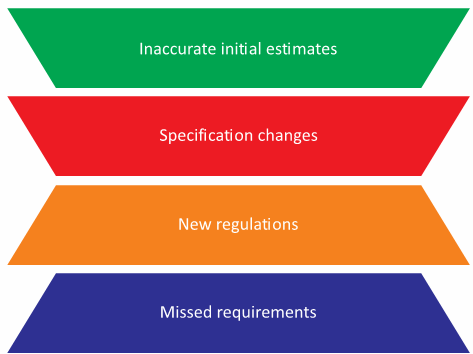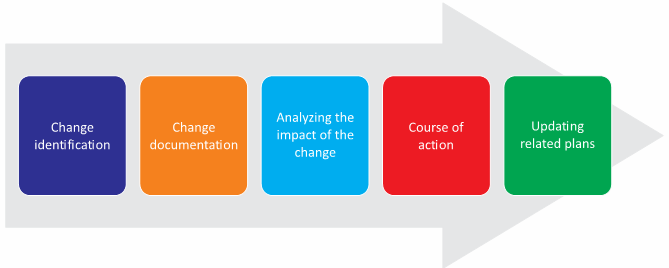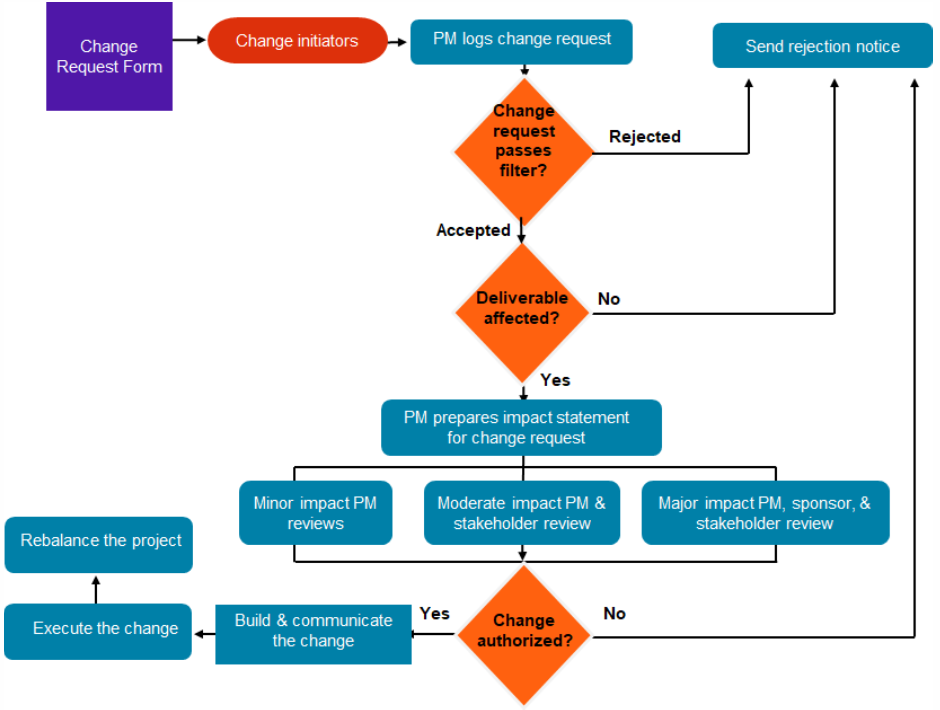Manage project changes
Enablers
- Anticipate and embrace the need for change. (ECO 2.10.1)
- Determine strategy to handle change. (ECO 2.10.2)
- Execute change management strategy according to the methodology. (ECO 2.10.3)
- Determine a change response to move the project forward. (ECO 2.10.4)
Deliverables, and Tools

Change Management Plan
Change management plan*: A component of the project management plan that establishes the change control board, documents that extent of its authority, and describes how the change control system will be implemented.
A change management plan can answer the following questions:
- Who can propose a change?
- What exactly constitutes a change?
- What is the impact of the change on the project's objectives?
- What steps are necessary to evaluate the change request before approving or rejecting it?
- When a change request is approved, what project documents must be amended to record the actions necessary to effect the change?
- How will these actions be monitored to confirm that they have been completed satisfactorily?
Causes of Project Changes

Change Control Systems
A change control system * is a set of procedures that describes how modifications to the project deliverables and documentation are managed and controlled.
An effective change control system includes:
- Forms
- Tracking methods
- Processes
- Approval levels required for authorizing or rejecting requested changes.
A Change Control Board (CCB) * is a formally chartered group responsible for reviewing, evaluating, approving, delaying, or rejecting changes to the project, and for recording and communicating such decisions.
Change Control Strategy

Change Management Process Flowchart

Advantages of Effective Change Management
Effective change management presents several advantages to project managers, including:
- Faster response time.
- Maximum traceability of changes.
- Increased team awareness of change needs.
- Increased engagement of team and stakeholders, internally and externally.
- Better team support for change requirements.
- An organizational framework for moving forward effectively.
Detailed Process for Making Changes
- Prevent the root cause of changes
- Identify the need for a change
- Evaluate the impact of the change within the knowledge area
- Create a change request
- Perform integrated change control
- Assess the change to all KAs
- Identify options
- The change is approved, rejected, or deferred by CCB (Change Control Board). The project manager may be able to approve many changes.
- Update the status of the change in the change log.
- Adjust the project management plan, project documents, and baselines as necessary.
- Manage stakeholders’ expectations by communicating the change to stakeholders affected by the change.
- Manage the project to the revised project management plan and project documents
Approved Change Requests
Approved change requests are requests that have been reviewed and approved in accordance with the integrated change control plan and are ready to be scheduled for implementation.
Approved changes can include:
- Corrective action: Adjusts the performance of the project work with the project management plan.
- Preventive action: Ensures future performance of the project work with the project management plan.
- Defect repair: Modifies a non-conformance within the project.
- Updates: Modifies project documents and plans to reflect the project changes.
Guidelines to Manage Project Changes
- Make sure your change control system is cost-effective.
- Establish or make use of an existing CCB composed of project stakeholders to evaluate change requests.
- Document the effect the changes have on the applicable project baselines.
- Obtain approval from the appropriate parties for all change requests before implementing the change.
- Use configuration management to document and control changes to original product characteristics.
- Coordinate changes across knowledge areas as appropriate. For example, does a proposed schedule change affect cost, risk, quality, and/or staffing?
- Use performance reports to measure project performance and assess whether planned variances require corrective action.
- Identify corrective action necessary to bring expected performance in line with the project plan.
- Update the project plan to reflect changes made that affect performance baselines.
- Document the causes of variances, the steps taken to correct performance problems, and the rationale behind the decision-making process.